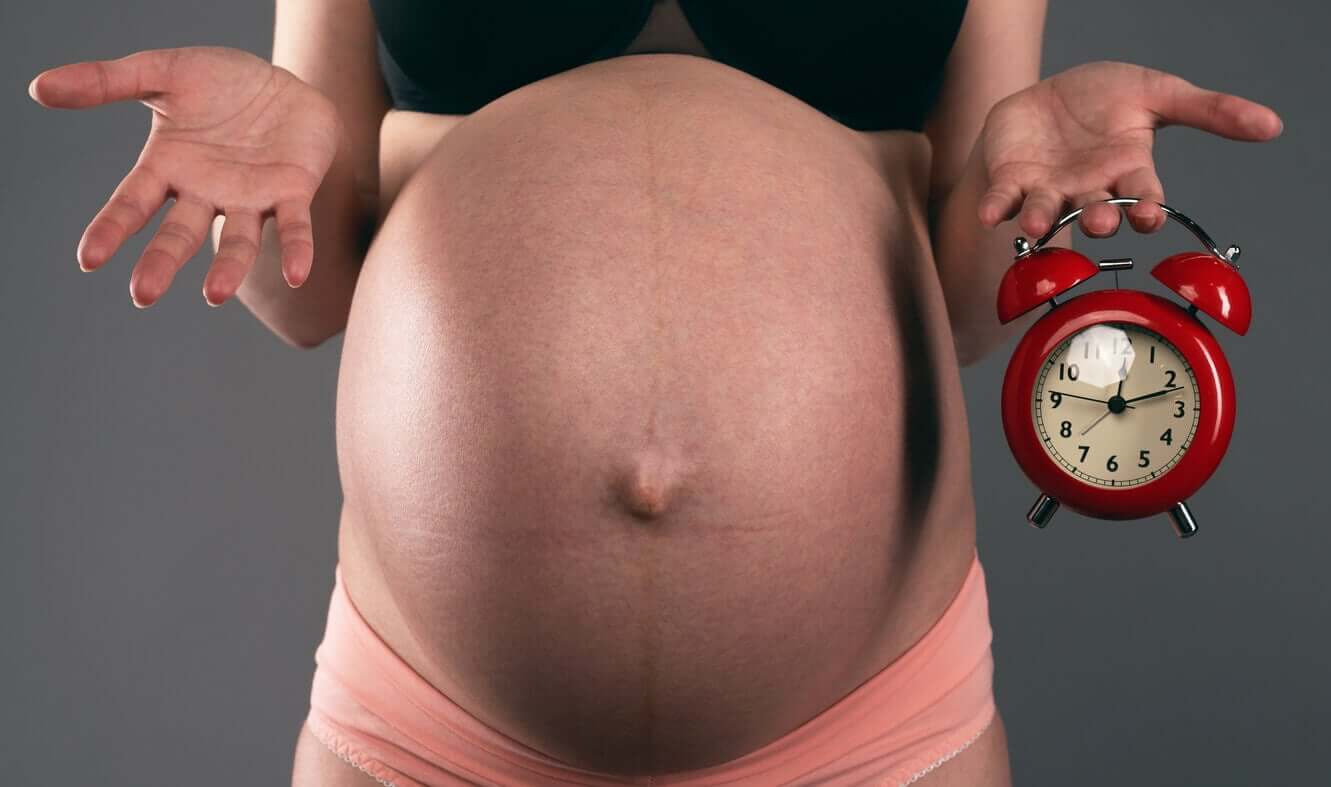Equivalence Between Weeks and Months of Pregnancy

When you receive confirmation that your baby is on the way, the first question that arises is when it will be born. In fact, you won’t be the only one who asks this question from then on, as everyone around you will be looking forward to that day. But knowing the probable date of birth has other purposes, such as providing you and the baby with the necessary care at each stage of pregnancy. And in this sense, talking about weeks instead of months of pregnancy is much more precise and appropriate.
Below, we’ll tell you about the equivalences between both parameters and everything you need to know to calculate what stage of pregnancy you’re in yourself. Keep reading!
How many weeks pregnant am I?… And months?

It’s common to see the puzzled face of people when they ask us “how far along are you” and we answer with a number of weeks. And the fact of the matter is, calculating the months of pregnancy isn’t always so simple and is often confusing.
The truth is that despite popular preferences, in medicine, it’s been established that the most appropriate cyclical unit to estimate the age of the fetus is the completed gestation week (Cunningham et al, 2019). This means the number of full weeks that have elapsed since day 1 of the pregnancy.
The reason why doctors prefer to divide the pregnancy in this way is based on the following questions:
- In general, human gestation lasts 280 days, which is equivalent to 40 weeks. However, the variation in the duration of pregnancy between two different women can exceed 10 days, so this number is an average.
- Except for the month of February, the rest of the months of the year have 30 or 31 days. If we do a quick calculation and divide 280 days by 30, the result is 9.33 months.
- For practical purposes, obstetric control at week 5 is very different from that at week 8, although in both cases it’s the second month of gestation. Therefore, it’s not functional to classify the stages of pregnancy in this way.
For all of these reasons, when you go to your first obstetric consultation, your doctor won’t speak in terms of months of pregnancy, but will calculate how far along your pregnancy is in weeks and days.
Calculation of gestational age and estimated date of delivery
Gestational age (GA) is the time elapsed from the first date of your last menstrual (LMP) and the given moment. This parameter is used to estimate the development that your baby has reached and to properly schedule future medical check-ups.
Although ovulation doesn’t usually coincide with the onset of menstruation, this phenomenon is highly variable among women and is difficult to estimate and generalize.
To calculate the GA of your future baby in the first prenatal visit, your doctor will take into account your last menstruation. From that date, they’ll calculate the number of full weeks and days that have elapsed since the first day of bleeding.
If your LMP was on 10/1/2021 and you attend the consultation on 11/7/2021, the estimated gestational age of your baby will be 6 weeks and 2 days.
Then, your doctor will proceed to estimate the probable date of your baby’s birth. To do this, you can use a simple calculation called Naegele’s rule. In fact, you can put it into practice yourself with these step-by-step instructions:
- Take the first day of your last period or menstrual bleeding as a reference. For example, 11/23/2021.
- Add 7 days. In the example above it would be 11/30/2021.
- Now subtract 3 months. If we follow the same example, 08/30/2021.
- Finally, add one year to get your expected due date (FPP): 08/30/2022.
Importantly, both GA and EDD are currently corroborated by objective parameters in first-trimester ultrasound (American College of Obstetricians and Gynecologists, 2017).
Weeks, months, and trimesters of pregnancy
As we’ve mentioned, the best way to estimate the progress of the pregnancy is to speak of weeks instead of months of pregnancy. However, these units can be grouped into quarters.
In general, each quarter consists of 14 weeks, although you’ll see that this varies depending on the reference source. According to Cunningham and colleagues (Williams Obstetricia, 2019), the three trimesters of pregnancy are divided as follows:
- First trimesters: From conception to a full 14 weeks.
- Second trimester: Includes weeks 15 through 28.
- Third trimester: Covers the period from the beginning of week 29 until birth (approximately 41-42 weeks).

About the importance of early obstetric control
Beyond satisfying your family and friends with the probable date of birth, making an early prenatal visit is essential in order to preserve your health and that of your baby.
Knowing your background in time will allow the specialist to anticipate any potential risk situation. Likewise, it’ll offer you and your partner the possibility of accessing the best conditions of well-being to fully enjoy this magical stage. Congratulations!
When you receive confirmation that your baby is on the way, the first question that arises is when it will be born. In fact, you won’t be the only one who asks this question from then on, as everyone around you will be looking forward to that day. But knowing the probable date of birth has other purposes, such as providing you and the baby with the necessary care at each stage of pregnancy. And in this sense, talking about weeks instead of months of pregnancy is much more precise and appropriate.
Below, we’ll tell you about the equivalences between both parameters and everything you need to know to calculate what stage of pregnancy you’re in yourself. Keep reading!
How many weeks pregnant am I?… And months?

It’s common to see the puzzled face of people when they ask us “how far along are you” and we answer with a number of weeks. And the fact of the matter is, calculating the months of pregnancy isn’t always so simple and is often confusing.
The truth is that despite popular preferences, in medicine, it’s been established that the most appropriate cyclical unit to estimate the age of the fetus is the completed gestation week (Cunningham et al, 2019). This means the number of full weeks that have elapsed since day 1 of the pregnancy.
The reason why doctors prefer to divide the pregnancy in this way is based on the following questions:
- In general, human gestation lasts 280 days, which is equivalent to 40 weeks. However, the variation in the duration of pregnancy between two different women can exceed 10 days, so this number is an average.
- Except for the month of February, the rest of the months of the year have 30 or 31 days. If we do a quick calculation and divide 280 days by 30, the result is 9.33 months.
- For practical purposes, obstetric control at week 5 is very different from that at week 8, although in both cases it’s the second month of gestation. Therefore, it’s not functional to classify the stages of pregnancy in this way.
For all of these reasons, when you go to your first obstetric consultation, your doctor won’t speak in terms of months of pregnancy, but will calculate how far along your pregnancy is in weeks and days.
Calculation of gestational age and estimated date of delivery
Gestational age (GA) is the time elapsed from the first date of your last menstrual (LMP) and the given moment. This parameter is used to estimate the development that your baby has reached and to properly schedule future medical check-ups.
Although ovulation doesn’t usually coincide with the onset of menstruation, this phenomenon is highly variable among women and is difficult to estimate and generalize.
To calculate the GA of your future baby in the first prenatal visit, your doctor will take into account your last menstruation. From that date, they’ll calculate the number of full weeks and days that have elapsed since the first day of bleeding.
If your LMP was on 10/1/2021 and you attend the consultation on 11/7/2021, the estimated gestational age of your baby will be 6 weeks and 2 days.
Then, your doctor will proceed to estimate the probable date of your baby’s birth. To do this, you can use a simple calculation called Naegele’s rule. In fact, you can put it into practice yourself with these step-by-step instructions:
- Take the first day of your last period or menstrual bleeding as a reference. For example, 11/23/2021.
- Add 7 days. In the example above it would be 11/30/2021.
- Now subtract 3 months. If we follow the same example, 08/30/2021.
- Finally, add one year to get your expected due date (FPP): 08/30/2022.
Importantly, both GA and EDD are currently corroborated by objective parameters in first-trimester ultrasound (American College of Obstetricians and Gynecologists, 2017).
Weeks, months, and trimesters of pregnancy
As we’ve mentioned, the best way to estimate the progress of the pregnancy is to speak of weeks instead of months of pregnancy. However, these units can be grouped into quarters.
In general, each quarter consists of 14 weeks, although you’ll see that this varies depending on the reference source. According to Cunningham and colleagues (Williams Obstetricia, 2019), the three trimesters of pregnancy are divided as follows:
- First trimesters: From conception to a full 14 weeks.
- Second trimester: Includes weeks 15 through 28.
- Third trimester: Covers the period from the beginning of week 29 until birth (approximately 41-42 weeks).

About the importance of early obstetric control
Beyond satisfying your family and friends with the probable date of birth, making an early prenatal visit is essential in order to preserve your health and that of your baby.
Knowing your background in time will allow the specialist to anticipate any potential risk situation. Likewise, it’ll offer you and your partner the possibility of accessing the best conditions of well-being to fully enjoy this magical stage. Congratulations!
All cited sources were thoroughly reviewed by our team to ensure their quality, reliability, currency, and validity. The bibliography of this article was considered reliable and of academic or scientific accuracy.
- Atención prenatal. In: Cunningham F, Leveno KJ, Bloom SL, Dashe JS, Hoffman BL, Casey BM, Spong CY. eds. Williams Obstetricia. 25° edición. McGraw Hill. 2019. Disponible en: https://accessmedicina.mhmedical.com/content.aspx?bookid=2739§ionid=229282096
- Fabre González E, Mateo Alcalá P, Carazo Hernández B, Orós López D. Consulta prenatal. Capítulo 7. En: González-Merlo. Obstetricia. 7ma Edición. Elsevier España. 2018. Páginas 99-120.
- Oficina de salud para la mujer. Etapas del embarazo. [Internet]. Consultado noviembre 2021. Disponible en: https://espanol.womenshealth.gov/pregnancy/youre-pregnant-now-what/stages-pregnancy
- Gil Almira, Antonio Embarazo: diagnóstico, edad gestacional y fecha del parto. MEDISAN. 2008;12(4): .[fecha de Consulta 23 de Noviembre de 2021]. ISSN: . Disponible en: https://www.redalyc.org/articulo.oa?id=368445249017
- American College of Obstetricians and Gynecologists: Method for estimating the due date. Committee Opinion No. 700, May 2017e
This text is provided for informational purposes only and does not replace consultation with a professional. If in doubt, consult your specialist.








